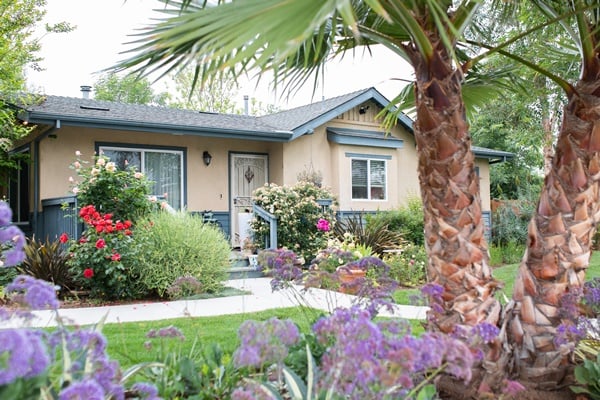
Whether you’ve got your eye on traveling more, enjoying more time with grandkids or devoting less precious time to home upkeep, you can spend more time doing what you love every day at a residential living community.
Considering whether a retirement community would be right for you starts with looking at the benefits of residential living versus staying in your current home. For many seniors, the great debate usually starts with questions about costs of living and health care, as well as staying social, active and engaged—after all, you want to grow, not grow old.
Let’s take a look at each factor in order to help you determine whether retirement community residential living, also called independent living, is right for you.
The Social Factor
At a senior care community, it doesn’t matter whether you’re an extrovert or introvert, because living in a Life Plan Community, also known as a continuing care retirement community (CCRC), provides a built-in network of neighbors and friends and life-enriching activities to keep you as busy as you want to be.
"I've gotten to develop some good friendships, and people that look after you as if you were a family member," says a resident of Redwood Terrace in Escondido, California. "It's a family; that's just the way people are here."
If you don’t feel comfortable driving at night and don’t get out much or you find it difficult to meet people because you’re an introvert, residential living can feed you emotionally and socially, which scientific evidence has shown helps you live a longer, happier life.
“Being involved in a local, face-to-face community gives people a sense of belonging and purpose, which are so vital to health, happiness and living a long life,” says Susan Pinker, the author of The Village Effect: How Face-to-Face Contact Can Make Us Healthier and Happier. “Interacting with people every day—people who are in close proximity—improves your resilience and immunity.”
Active older adults in residential living communities have endless options for activities, too. You can go about your day on your own terms or take advantage of a community’s endless activities and amenities. At Redwood Terrace, for example, you could:
- Whittle away the day in the woodworking shop.
- Catch a show at the Patio Playhouse.
- Pick up a pint at Stone Brewing.
- Explore the San Diego Children's Discovery Museum with your grandkids.
- Relax in the wellness center and spa.
Additionally, some communities make it easier to get out and about locally and even globally by offering travel programs where residents can go on day trips or extended vacations together.
Residential living communities also offer housekeeping, transportation services, dining and access to wellness programs and fitness centers with trainers so you can spend more time doing what you love and less time managing the nitty-gritty of daily life—like all of the expenses of staying in your current home.
The Cost Factor
It may surprise you to know that if you’ve owned a home in California, living in a retirement community with an entrance fee will likely be affordable for you—and the all-inclusive monthly fees may compare quite favorably to the costs of staying in your current home. Just consider all that would be included in your monthly fee at most CCRCs:
- Educational and fitness classes.
- Chef-prepared meals.
- Cable and utilities.
- All home maintenance—inside and out.
- Regularly scheduled housekeeping.
- Transportation to medical appointments.
- Activities for the mind, body and spirit.
In fact, residential living is a cost-effective living option when you consider all of the costs associated with staying in your current home that you’ll no longer have to pay, including:
- Mortgage.
- HOA fees.
- Property taxes.
- Utilities.
- Home maintenance.
- Unexpected home repairs (e.g., roof repairs, appliance replacement).
- Transportation fees.
The Senior Care Factor
Another of the biggest financial benefits of residential living is that you receive predictably priced priority access to advanced levels of health care for seniors should the need ever arise, including:
- Assisted living.
- Memory care.
- Short-term post-acute rehabilitation.
- Long-term skilled nursing care.
A CCRC is also the perfect option for a couple whose senior care needs differ, because all living options are available on a single campus. So, for example, Peter can enjoy independent and active residential living while his wife Sue, who has dementia, can live comfortably on campus in the memory care residences—and they can see each other daily and participate in activities together as well.
Additionally, at a Life Plan Community like Redwood Terrace in Escondido, you’ll receive benevolent support if, through no fault of your own, you outlive your financial resources. For you, your heirs and other loved ones, knowing that you have a plan for your future offers peace of mind and security.
When to Make the Move
If you’re considering residential living, the best time to move into a CCRC and take advantage of everything independent living has to offer is when you’re healthy and able to enjoy it—which means now.
To be an independent living resident at North County’s Redwood Terrace, you must be physically independent and able to get around without assistance, and you also need to be able to manage your own medications and go about your daily activities without the need for any supervision. If anything ever changes and you need more advanced health care services, having moved in at the residential living level means you’ll be part of a family of neighbors and staff who will be there to support you.
If you’re exploring communities with residential living options in North County, come visit us at Redwood Terrace. Located in the heart of Escondido, Redwood Terrace’s intimate size creates a neighborhood environment and friendly, family-oriented atmosphere. Contact us today to set up a personalized tour of our maintenance-free independent living cottages, apartments and off-campus single-family homes.



.png?width=260&height=56&name=new-hg-logo-rev-with-registered-mark%20(2).png)